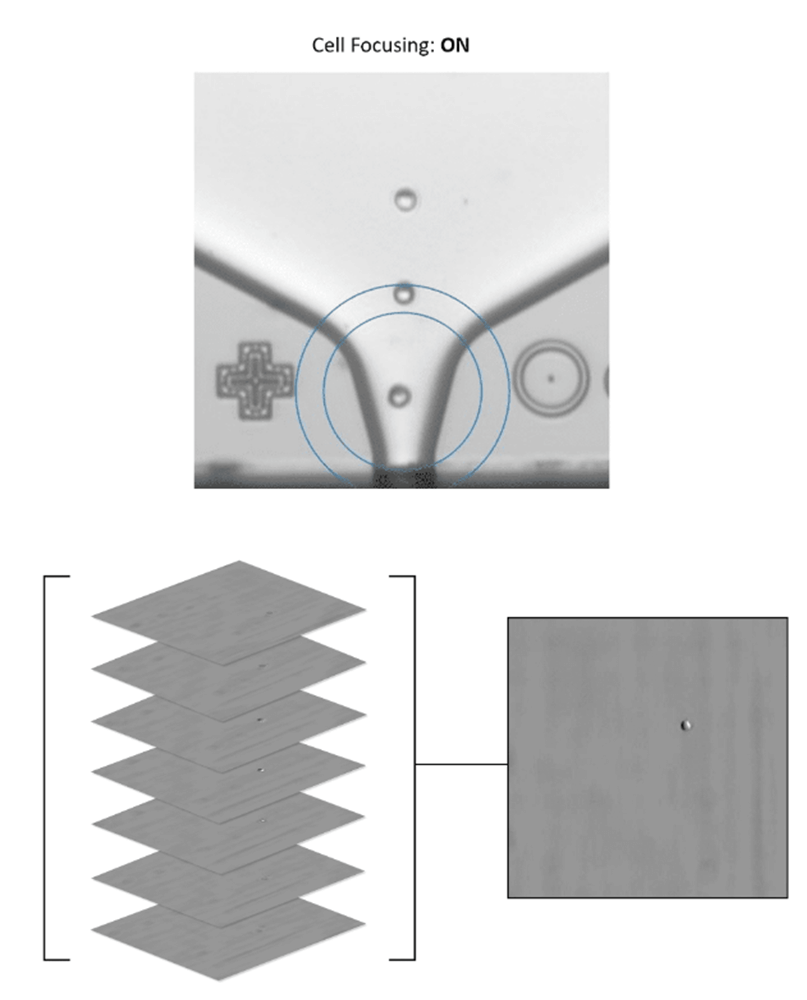- PRODUCTS
-
UP.SIGHT™ 2nd GenNEW
Optimized For Proof Of Monoclonality, Colony Tracking, Confluency, & Titer Measurement -
F.SIGHT™ 2.0
Optimized For Rapid Dispensing of Fluorescent Cells -
C.SIGHT™ 2.0
Optimized for Powerful Dispensing of Unlabeled Cells -
B.SIGHT™
Optimized For Rapid Microbial Single-Cell Isolation and Cultivation -
F.SIGHT™ OMICS
Optimized For Single-Cell-Omics -
F.SIGHT™
Optimized For Affordability And Flexibility -
C.SIGHT™
Optimized for Affordable Cell Line Development -
Compare Products
Decide which one is right for you - Help Me Choose
-
UP.SIGHT™ 2nd GenNEW
- APPLICATIONS
- CUSTOMERS
- RESOURCES HUB
- COMPANY
- SHOP
Precision in Single-Cell Seeding: Key Strategies for Success
In cell line development (CLD), generating high-quality, monoclonal cell populations is essential for therapeutic and research applications1. Precision single-cell seeding plays a vital role in this process, enhancing cell line purity, scalability, the isolation of rare cells, and aiding regulatory compliance. Robust quality control (QC) and monitoring protocols are fundamental to success in single-cell seeding workflows, which have many potential pitfalls that slow research efforts. New technologies such as automation can help researchers overcome these challenges and streamline the development of therapies in areas like regenerative medicine and oncology. Here, we discuss the importance of single-cell seeding, tactics for improving success, and the role of single-cell seeding in transforming healthcare.
The Importance of Single-Cell Seeding
Generating a cell population from a single clone (monoclonality) is a crucial starting point for many therapeutic and technological applications. Monoclonality provides a solid foundation for efficiency and excellence in everything that follows CLD and is a core advantage of precision in single-cell seeding.
Enhanced Quality
Today, cells are used to produce biological therapies and as standalone therapeutic agents2. Thus, ensuring cells are derived from a single verifiable source is as important as guaranteeing no contaminants in a pharmaceutical drug formulation. The higher the purity of a cell population, the higher the end performance in therapeutic quality.
Traceability and Regulatory Compliance
Regulatory bodies pay close attention to the purity and origin of potential therapeutics3. Precision single-cell seeding provides companies with a robust way to maintain documented proof of monoclonality at every step of the workflow. Advanced software, like C-STUDIO from CYENA, makes it simple to manage the huge amount of data required to record and demonstrate clonality. It’s worth noting that some methods of single-cell seeding are far better for ensuring compliance than others.
Scalability
Single-cell seeding allows for workflow minimization, which means that researchers save money on the reagents and consumables needed to maintain higher numbers of cells. Similarly, single-cell dispensing increases research throughput by allowing the use of multiwell formats that fit more readily within automated workflows. CYTENA takes a modern approach to single-cell seeding, allowing researchers to scale down to a 384-well plate format. This reduces the volume of reagents and is ideal for automated workflows.
Isolation of Rare Cells
Many applications require the isolation and culturing of rare cells from complex mixtures. Single-cell seeding techniques facilitate the sorting of complex mixtures, which can give researchers significant insights into rare cell populations in areas like oncology and microbiome research4.
QC and Monitoring
Given the importance of purity and verification in using cell lines as therapies or to produce therapies, robust QC and monitoring protocols are essential. Mistakes early on can lead to a considerable loss of resources later on and significantly prolong regulatory approval timelines.
Dispensing and Accuracy
Monitoring is essential to ensure that a single cell has been added to a well. Different methods for single-cell seeding require different QC and monitoring approaches. Some dispensing methods rely on serial dilutions and probabilities5, while others, like the CYTENA UP.SIGHT, use microfluidics and a dual imaging system to achieve a >99.99% probability of clonality (Fig. 1).

Figure 1. The UP.SIGHT’s Cell Focusing feature and day-0 3D well imaging gives researchers confidence in achieving monoclonality.
Cell Viability and Purity
After dispensing, it is essential to verify cellular viability and purity. These factors are fundamental to utilizing the cell line for downstream applications. Determining cell viability is particularly important when working with cells like induced pluripotent stem cells (iPSCs) that are sensitive to shear stresses associated with some cell sorting methods like FACS. Furthermore, single cells are easy to miss when manually monitoring cells with a conventional light microscope. Manual monitoring for monoclonality becomes easier as the cells begin to proliferate but is time-consuming and error-prone compared to advanced imaging approaches, such as those used by the UP.SIGHT single-cell dispenser and imager from CYTENA.
Hit Selection
Monitoring cell growth is vital for deciding which clones to pursue for further analysis. Scaling up cell production increases resource allocation, so researchers must use robust methods to establish promising hits while remaining resource-efficient. In many cases, researchers must look beyond cell proliferation and investigate factors like the yield of the target protein produced by cells to evaluate hits6.
Automation
Automated processes are incredibly powerful in precision single-cell seeding and eliminate many perennial challenges associated with achieving monoclonality. Automation provides higher precision and accuracy in single-cell dispensing by minimizing the error caused by manual inputs. Automation also increases throughput by allowing more clones to be seeded and tested simultaneously. This leads to shortened timelines and reduced operational costs associated with lengthy screening processes. Contamination, either from other cellular clones or by microorganisms, poses a significant risk to CLD workflows. Automation in single-cell seeding significantly reduces the chances of contamination, enhancing the quality of the end product while derisking workflows substantially. The C.STATION from CYTENA provides an end-to-end automation solution, streamlining and derisking CLD workflows.
For more information on the power of automation in single-seeding you can read our article dedicated to the topic.
Applications
Precision in single-cell seeding impacts many areas of healthcare and research due to its ability to provide a verifiably pure cell population.
Healthcare
Single-cell seeding has been transformative in healthcare by allowing the purification of a cell population to produce therapies. Fields like regenerative medicine, oncology, immunology, and neurological diseases rely on precision single-cell seeding for current and future therapies. Prominent examples include CAR-T cell immunotherapy7 and modern antibody-based therapies8 (Fig. 2) that depend on hybridoma technology.
Translational Research
Producing cell lines with specific genetic alterations, such as a gene mutation or deletion, is fundamental to biological research. These lines allow researchers to study the function of different genes and understand how they contribute to disease. In cancer biology, single-cell seeding can be used to study tumor heterogeneity by allowing researchers to culture individual cell populations from tumors and examine their growth or response to different drugs.

Figure 2. Single-cell dispensing using the UP.SIGHT from CYTENA enables the production of next-generation therapies.
Challenges in Single-Cell Seeding
Single-cell seeding is a complex process with many potential pitfalls9. The primary challenge is ensuring a monoclonal population in a single well. This is difficult to achieve, as manual methods such as serial dilutions do not guarantee one cell per well but instead rely on probability across many wells. This means large sample volumes are required which can put a strain on resources. Many cell types do not grow as well as individual cells, which can limit the utility of single-cell seeding in studying these populations. Furthermore, some cells are sensitive to stresses experienced during sorting. This can lead to slow proliferation and loss of cell viability, which significantly prolongs CLD timelines. Advanced techniques for precision single-cell seeding can help achieve monoclonality; however, they often require specific expertise and can be technically challenging to execute.
Conclusion & Future Trends
Precision in single-cell seeding is crucial for efficient CLD workflows, ensuring monoclonality and enhancing therapeutic quality. Automation is a game-changer in single-cell dispensing by reducing risks like contamination and shortening timescales. Technologies that utilize AI and advanced imaging to ensure single-cell dispensing and help identify hits are at the cutting edge of single-cell seeding techniques. Microfluidics systems and real-time monitoring can help promote cell viability and early hit detection. These innovations promise to enhance the efficiency and scalability of single-cell seeding in CLD and streamline the generation of future therapies.
CYTENA’s suite of advanced instruments offers best-in-class results by utilizing the latest advanced single-cell detection algorithms, data acquisition, and imaging analysis, allowing researchers to move away from traditional forms of cell sorting.
Book a demo today to learn more about the UP.SIGHT single-cell dispenser and how it can help you overcome challenges in precision single-cell seeding.
References
- Lai T, Yang Y, Ng SK. Advances in Mammalian cell line development technologies for recombinant protein production. Pharmaceuticals (Basel). 2013;6(5):579-603. doi:10.3390/ph6050579
- Wang LL, Janes ME, Kumbhojkar N, et al. Cell therapies in the clinic. Bioengineering & Transla Med. 2021;6(2):e10214. doi:10.1002/btm2.10214
- World Health Organization. WHO Expert Committee on Biological Standardization. World Health Organ Tech Rep Ser. 2013;(979):1-366, back cover.
- Lloréns-Rico V, Simcock JA, Huys GRB, Raes J. Single-cell approaches in human microbiome research. Cell. 2022;185(15):2725-2738. doi:10.1016/j.cell.2022.06.040
- Gross A, Schoendube J, Zimmermann S, Steeb M, Zengerle R, Koltay P. Technologies for Single-Cell Isolation. Int J Mol Sci. 2015;16(8):16897-16919. doi:10.3390/ijms160816897
- Dumont J, Euwart D, Mei B, Estes S, Kshirsagar R. Human cell lines for biopharmaceutical manufacturing: history, status, and future perspectives. Crit Rev Biotechnol. 2016;36(6):1110-1122. doi:10.3109/07388551.2015.1084266
- Mitra A, Barua A, Huang L, Ganguly S, Feng Q, He B. From bench to bedside: the history and progress of CAR T cell therapy. Front Immunol. 2023;14:1188049. doi:10.3389/fimmu.2023.1188049
- Kothari M, Wanjari A, Acharya S, et al. A Comprehensive Review of Monoclonal Antibodies in Modern Medicine: Tracing the Evolution of a Revolutionary Therapeutic Approach. Cureus. Published online June 9, 2024. doi:10.7759/cureus.61983
- Clarke H, Mayer‐Bartschmid A, Zheng C, et al. When will we have a clone? An industry perspective on the typical CLD timeline. Biotechnology Progress. Published online March 13, 2024:e3449. doi:10.1002/btpr.3449





